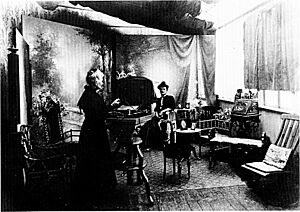Frederikke Federspiel facts for kids
Frederikke Jakobine Federspiel (1839–1913) was a very important person in Danish photography. She was the first woman to become a professional photographer in Denmark. For many years, she had her own photo studio in Aalborg. She always made sure to learn about the newest camera technologies.
Even princesses like Dagmar and Alexandra were her clients! They loved her special jewelry that had tiny photos inside.
Contents
Early Life
Frederikke was born in Horsens, Jutland, in 1839. She grew up in a well-off family with her sister and five brothers. When she was only six, her father passed away. After that, her mother became a milliner, making and selling hats, to support the family.
In 1874, after her mother died, Frederikke traveled to Hamburg, Germany. She wanted to learn how to be a photographer. She lived with her uncle and aunt there. Her cousin, Alfred Lewitz, was also a photographer, and Frederikke became his apprentice. She wrote in her diary that she really enjoyed her year in Hamburg. She went on many trips, saw plays at the theater, and had wonderful meals.
Becoming a Photographer
After finishing her training in 1876, Frederikke Federspiel returned to Denmark. She was the first woman in the country to ask for a license to work as a photographer. She decided to open her studio in Aalborg and moved there with her sister, Sophie.
Sophie used the living room for her business, selling lingerie and embroidery. Frederikke set up her photo studio on the top floor. There were already two other photographers in Aalborg, including a well-known one named Heinrich Tønnies. Frederikke knew about the competition. But she was smart and advertised her business well. She always kept up with new photography methods.
For a long time, her studio was the second most successful in Aalborg. In 1878, she became ill and spent eight months in the hospital. Then she spent three more months at a health spa in Modum, Norway. She visited this spa several times in later years. She also enjoyed summer holidays with her sister at seaside resorts like Blokhus, Løkken, and Fanø.
Joining the Photographers Association
In 1883, Frederikke Federspiel and Nielsine Zehngraf were among the first women to join the Danish Photographers Association. Frederikke was an active member. She helped create the Association's photo album. In 1885, she was recognized for donating portraits. She also showed her work in Copenhagen and often attended the exhibitions herself, like in 1888.
Photo Jewelry
In 1899, Frederikke started making special jewelry. She created enamel jewelry and cufflinks with tiny photos inside them. She used a special camera with four lenses imported from the United States to make these unique items.
Her photo jewelry was shown at a Christmas exhibition in Copenhagen. The royal family noticed her work! Because of this, Princess Alexandra and Tsaritsa Dagmar became her clients.
Keeping Up with Technology
Frederikke was always interested in the newest technology. She quickly started using dry plates for her photos. This method was safer and cheaper for taking and developing pictures. She was also one of the first to try magnesium powder for flash photography. When electricity came to Aalborg in 1901, she installed electric lamps in her studio right away.
In the early 1900s, she began selling cameras to people who wanted to take photos as a hobby. Some of her students and assistants, like Ernst Gøpel and Georg Bendtzen Holm, later became famous photographers themselves.
Her Legacy
Frederikke Federspiel always used the latest photography methods. Even though she once said her business hadn't grown as much as she hoped, she was highly respected. When she passed away in 1913, the Dansk Fotografisk Tidsskrift (Danish Photography Magazine) praised her. They called her "an unusually likable, honest and energetic lady whose work has been counted among the best."
See also
- Photography in Denmark
- History of photography


